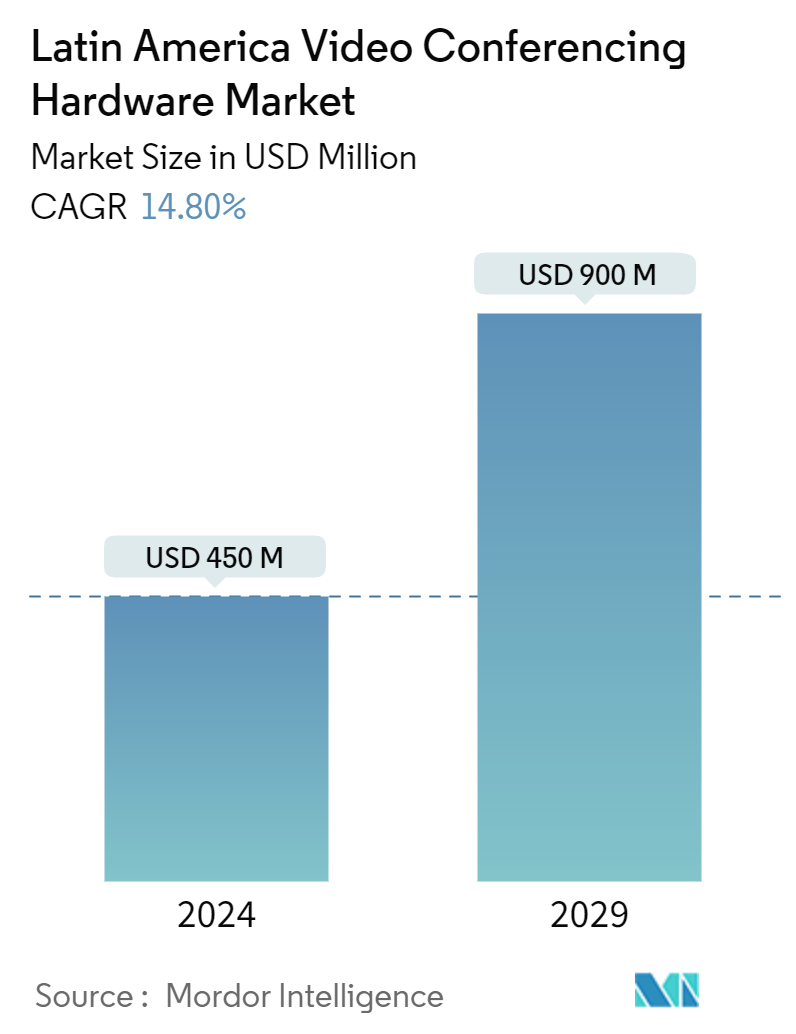Market Size of Latin America Video Conferencing Hardware Industry

| Study Period | 2019 - 2029 |
| Base Year For Estimation | 2023 |
| Market Size (2024) | USD 450 Million |
| Market Size (2029) | USD 900 Million |
| CAGR (2024 - 2029) | 14.80 % |
| Market Concentration | High |
Major Players
*Disclaimer: Major Players sorted in no particular order |
Latin America Video Conferencing Hardware Market Analysis
The Latin America Video Conferencing Hardware Market size is estimated at USD 450 million in 2024, and is expected to reach USD 900 million by 2029, growing at a CAGR of 14.80% during the forecast period (2024-2029).
- Video conferencing hardware encompasses the physical elements and devices required to facilitate practical video conferencing sessions. This equipment assists in capturing, processing, and transmitting video and audio signals among participants in a video conference. Video conferencing systems usually include hardware such as multi control units (MCU), collaboration bars, codec systems, USB cameras, USB-based integrated bars, other bundled kits, and enterprise headsets. For instance, codec serves as the central processing unit of a video conferencing system. Its primary function is to compress and decompress audio and video data to minimize the bandwidth needed while preserving high-quality output.
- The adoption of remote work and telecommuting in Latin America has surged, particularly in response to the pandemic. This shift has increased the demand for video conferencing hardware solutions as organizations seek practical tools to facilitate virtual meetings, collaboration, and communication among remote teams. For instance, in October 2023, Logitech launched two new products that utilize artificial intelligence to improve video collaboration in rooms and meeting spaces. The devices are called Logitech Sight and Logitech Rally Bar Huddle. The Rally Bar Huddle is an all-in-one video bar that enhances meeting experiences by incorporating AI, 4K video quality, and advanced sound pickup designed for small meeting spaces.
- The popularity of virtual events, webinars, and online conferences drives the demand for video conferencing hardware in countries like Brazil, Mexico, and Argentina. Businesses, event organizers, and educational institutions leverage video conferencing solutions to host virtual seminars, training sessions, and customer engagement, reach broader audiences, and enhance equipment. In addition, video conferencing hardware is being increasingly utilized in the region's healthcare sector for telemedicine consultations, remote patient monitoring, and virtual healthcare delivery.
- The substantial upfront cost of creating and installing video conferencing hardware, particularly for extensive projects, may hinder market expansion. The necessity for significant infrastructure investments like retrofitting to facilitate the incorporation of video conferencing hardware into current energy systems can pose a limitation. Moreover, compliance requirements, data protection regulations, and legal frameworks governing communication technologies may pose compliance challenges for organizations deploying video conferencing hardware in the region.
- Macroeconomic factors like rapid technological advancements, product innovation, and the introduction of new features and functionalities can drive the demand for video conferencing hardware. Investments in research and development, the introduction of innovative technologies like cloud computing, IoT (Internet of Things), and AI (artificial intelligence), and the creation of integrated communication platforms could potentially increase the need for sophisticated video conferencing hardware in Latin America.
Latin America Video Conferencing Hardware Industry Segmentation
For market estimation, revenue generated is tracked from the sale of video conferencing hardware offered by different market players for a diverse range of applications. Market trends are evaluated by analyzing investments made in product innovation, diversification, and expansion. Further, advancements in multi-control units (MCU), enterprise headsets, and USB cameras are crucial in determining the growth of the market.
The Latin American video conferencing hardware market is segmented by type of hardware (multi control units (MCU), collaboration bars, codec systems, USB cameras, USB-based integrated bars, other bundled kits, and enterprise headsets), end users (institutions and commercial spaces), and country (Brazil, Mexico, and Argentina). The report offers the market size and forecasts for all the above segments in value (USD).
| By Type of Hardware | |
| Multi Control Units (MCU) | |
| Collaboration Bars | |
| Codec Systems | |
| USB Cameras | |
| USB-based Integrated Bars | |
| Other Bundled Kits | |
| Enterprise Headsets |
| By End User | |
| Institutions | |
| Commercial Spaces |
| By Country | |
| Brazil | |
| Mexico | |
| Argentina |
Latin America Video Conferencing Hardware Market Size Summary
The Latin America video conferencing hardware market is experiencing significant growth, driven by the increasing adoption of remote work and the rising demand for virtual communication solutions. This market encompasses various physical devices essential for facilitating video conferencing sessions, such as multi control units, collaboration bars, codec systems, and enterprise headsets. The shift towards remote work, accelerated by the pandemic, has led organizations to seek effective tools for virtual meetings and collaboration. The popularity of virtual events and online conferences in countries like Brazil, Mexico, and Argentina further fuels this demand. Additionally, the healthcare sector's growing use of video conferencing for telemedicine and remote patient monitoring contributes to market expansion. However, the high upfront costs and infrastructure requirements for implementing these systems, along with compliance challenges, may pose obstacles to market growth.
The market is characterized by rapid technological advancements and product innovations, with companies like Logitech, HP|Poly, and Cisco introducing AI-driven solutions to enhance video collaboration. These advancements include features like 4K video quality, advanced sound pickup, and intelligent director capabilities, which improve meeting experiences and participation. The demand for video conferencing hardware is also bolstered by government initiatives promoting digitalization in Mexico, as well as the need for cost-effective communication solutions in commercial spaces. The competitive landscape is marked by significant players such as Logitech International SA, Poly Inc., EPOS, Jabra, Cisco Systems Inc., and Huawei Technologies Co. Ltd., who are expanding their market share through collaborations and innovative product offerings. As businesses continue to embrace digital transformation, the Latin America video conferencing hardware market is poised for substantial growth, offering opportunities for both established and emerging players.
Latin America Video Conferencing Hardware Market Size - Table of Contents
-
1. MARKET INSIGHTS
-
1.1 Market Overview
-
1.2 Industry Attractiveness - Porter's Five Forces Analysis
-
1.2.1 Threat of New Entrants
-
1.2.2 Bargaining Power of Buyers/Consumers
-
1.2.3 Bargaining Power of Suppliers
-
1.2.4 Threat of Substitute Products
-
1.2.5 Intensity of Competitive Rivalry
-
-
1.3 Technology Snapshot
-
1.4 Impact of COVID-19 Aftereffects and Other Macroeconomic Factors on the Market
-
-
2. MARKET SEGMENTATION
-
2.1 By Type of Hardware
-
2.1.1 Multi Control Units (MCU)
-
2.1.2 Collaboration Bars
-
2.1.3 Codec Systems
-
2.1.4 USB Cameras
-
2.1.5 USB-based Integrated Bars
-
2.1.6 Other Bundled Kits
-
2.1.7 Enterprise Headsets
-
-
2.2 By End User
-
2.2.1 Institutions
-
2.2.2 Commercial Spaces
-
-
2.3 By Country
-
2.3.1 Brazil
-
2.3.2 Mexico
-
2.3.3 Argentina
-
-
Latin America Video Conferencing Hardware Market Size FAQs
How big is the Latin America Video Conferencing Hardware Market?
The Latin America Video Conferencing Hardware Market size is expected to reach USD 450 million in 2024 and grow at a CAGR of 14.80% to reach USD 900 million by 2029.
What is the current Latin America Video Conferencing Hardware Market size?
In 2024, the Latin America Video Conferencing Hardware Market size is expected to reach USD 450 million.

